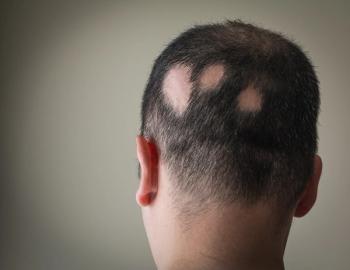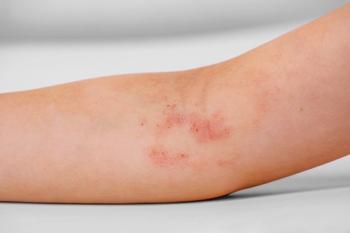
- Consultant for Pediatricians Vol 6 No 1
- Volume 6
- Issue 1
Thyroglossal Duct Cyst in an 8-Year-Old Girl
Eight-year-old girl with mass in midline of neck.Mass first noted about 6 months earlier. Patient is otherwise well; past health unremarkable. No symptoms ofhypothyroidism.
HISTORY
Eight-year-old girl with mass in midline of neck.Mass first noted about 6 months earlier. Patient is otherwise well; past health unremarkable. No symptoms ofhypothyroidism.
PHYSICAL EXAMINATION
Patient not in distress. Respiratory rate, 18 breaths/min; heart rate, 76 beats/min; temperature, 37.2°C (98.8°F). Cystic mass, 0.5 cm in diameter; not tender; moves upward with protrusion of the tongue. Examination otherwise normal.
Thyroglossal duct cysts are the most common cause of a midline neck mass in children.1 The cyst is a persistent remnant ofthyroglossal duct epithelial tissue.2
WHATS YOUR DIAGNOSIS?
EMBRYOLOGY
The thyroid anlage arises from the foregut diverticulum at the site of the future foramen cecum at about the third week of gestation.3,4 As the neck develops, the thyroid gland descends along the midline of the neck, between the first and second branchial arteries, andventral to the hyoid bone and the developing laryngeal cartilage.1,4 The thyroid gland remains connected to the foramen cecum by the thyroglossal duct during the descent. A cyst results when the thyroglossal duct fails to involute after the descent of the thyroid gland.
EPIDEMIOLOGY
The exact incidence is not known. Thyroglossal duct cysts account for approximately 70% of all congenital abnormalities of the neck.3 The sex ratio is equal.3,5 Most cases are sporadic. The cysts are occasionally inherited as an autosomal dominant disorder or,rarely, as an autosomal recessive disorder.6
CLINICAL MANIFESTATIONS
A thyroglossal duct cyst presents as a midline neck mass, which may move with swallowing and might move upward with protrusion of the tongue. However, its movement may be limited with protrusion of the tongue because of its persistent attachment to the foramen cecum.7
Approximately 1% of the cysts are located laterally, often on the left side.8 A thyroglossal duct cyst can occur at any site along the normal pathway of descent from the foramen cecum to the lower neck region.2 The most common site (61% of cases) is between the thyroid gland and the hyoid bone.8 Other potential sites include suprahyoidal (24%), suprasternal (13%), or intralingual (2%) locations.8
Although thyroglossal duct cysts are congenital, these lesions rarely present in the neonatal period.9 More commonly, the cysts are noted in preschool children,9 sometimes after an upper respiratory tract infection. At least 50% of the lesions are diagnosed in the second decade of life.7 Some do not present until adulthood. Presentation in the elderly is rare.10
COMPLICATIONS
Thyroglossal duct cysts commonly present as an infected neck mass (Figure).11 Recurrent infections are common if the lesion is not excised.Rarely, a thyroglossal duct cyst might cause extrinsic airway compression or intralaryngeal extension with resultant dyspnea or hoarseness.8 An intralingual thyroglossal duct cyst might result in dysphagia or speech impairment.8
A thyroglossal duct cyst has the potential for malignant transformation during childhood, but this is uncommon.1,10 Approximately 75% to 85% of thyroglossal duct malignancies are papillary adenocarcinomas. Follicular cell and squamous cell carcinomas also occur.1,10
DIFFERENTIAL DIAGNOSIS
The differential diagnosis includes midline dermoid cyst, ectopic thyroid tissue, lymphadenopathy, cystic hygroma, branchial cleft cyst, lipoma, lymphangioma, hemangioma, and sebaceous cyst.
HISTOPATHOLOGY
Thyroglossal duct cysts are lined by pseudostratified ciliated columnar epithelium (61% of cases), stratified squamous epithelium (38%), transitional epithelium (7%) or cuboidal epithelium (7%).8 The cysts contain colloid material with cholesterol crystals and phagocytes.1
DIAGNOSTIC STUDIES
Ultrasonography can be used to confirm the cystic nature of the lesion and the presence of a normal-appearing and normally situated thyroid gland. The ultrasonographic appearance of the lesion can be anechoic, homogeneously hypoechoic, or heterogeneous.1,12
TREATMENT
TheSistrunk procedure is the surgical treatment of choice.4,12 The procedure includes excision of the cyst, the thyroglossal tract, and the central portion of the hyoid bone to prevent recurrence.4,12
References:
REFERENCES:
1. Dedivitis RA, Camargo DL, Peixoto GL, et al. Thyroglossal duct: a review of 55 cases.
J Am Coll Surg.
2002;194:274-277.
2. Loh WS, Chong SM, Loh KS. Intralaryngeal thyroglossal duct cyst: implications for the migratory pathway of the thyroglossal duct.
Ann Otol Rhinol Laryngol.
2006;115:114-116.
3. Mohan PS, Chokshi RA, Moser RL, et al. Thyroglossal duct cysts: a consideration in adults.
Am Surgeon.
2005;71:508-511.
4. Phillips PS, Ramsay A, Leighton SE. A mixed thyroglossal cyst.
J Laryngol Otol.
2004;118:996-998.
5. Brousseau VJ, Solares CA, Xu M, et al. Thyroglossal duct cysts: presentation and management in children versus adults.
Int J Pediatr Otorhinolaryngol.
2003; 67:1285-1290.
6. Schader I, Robertson S, Maoate K, Beasley S. Hereditary thyroglossal duct cysts.
Pediatr Surg Int.
2005;21:593-594.
7. Turkyilmaz Z, Sonmez K, Karabulut R, et al. Management of thyroglossal duct cysts in children.
Pediatr Int.
2004;46:77-80.
8. Soliman AM, Lee JM. Thyroglossal duct cyst with intralaryngeal extension.
Ann Otol Rhinol Laryngol.
2006;115:559-562.
9. Kaselas CH, Tsikopoulos G, Chortis CH, et al. Thyroglossal duct cyst's inflammation. When do we operate?
Pediatr Surg Int.
2005;21:991-993.
10. Ducic Y. Thyroglossal duct cysts in the elderly population.
Am J Otolaryngol.
2002;23:17-19.
11. Schneiderman H. Infected thyroglossal duct cyst.
Consultant for Pediatricians.
2002;1:21-22.
12. Koch B. Cystic malformations of the neck in children.
Pediatr Radiol.
2005; 35:463-477.
Articles in this issue
almost 19 years ago
Polydactyly of the handalmost 19 years ago
Photoclinic: Systemic Allergic Reaction to Embedded Sewing Needlealmost 19 years ago
"Focus on Vaccines" Correction:almost 19 years ago
Foreign-Body Aspiration: A Guide to Early Detection, Optimal Therapyalmost 19 years ago
Pityriasis Rosea and Hot Tub Folliculitisalmost 19 years ago
Perianal Finding--Sexual Abuse or Normal Variant?almost 19 years ago
Photoclinic: Bilateral Clinodactyly of the Fifth Fingeralmost 19 years ago
Photo Quiz: Making the Rounds: Round 1almost 19 years ago
Top Papers Of The Month: Cough Medicine as a Drug of Abusealmost 19 years ago
Photoclinic: Giant Congenital Melanocytic NevusNewsletter
Access practical, evidence-based guidance to support better care for our youngest patients. Join our email list for the latest clinical updates.














